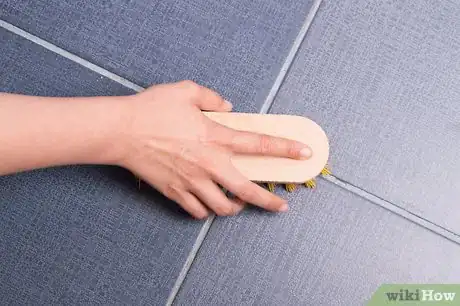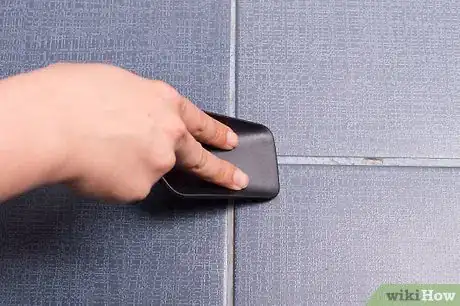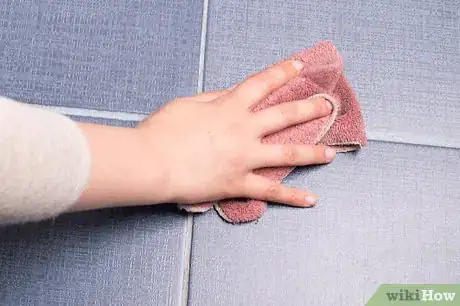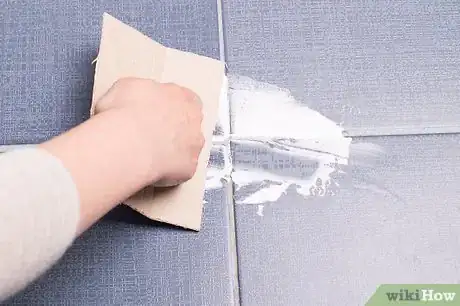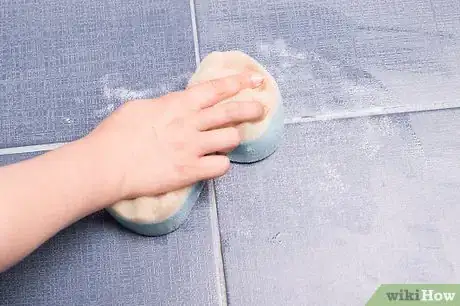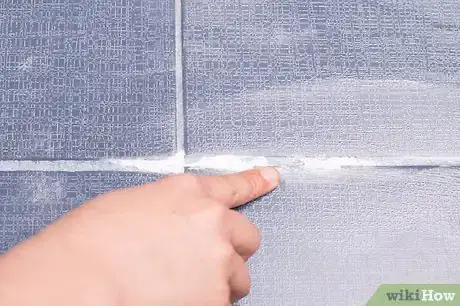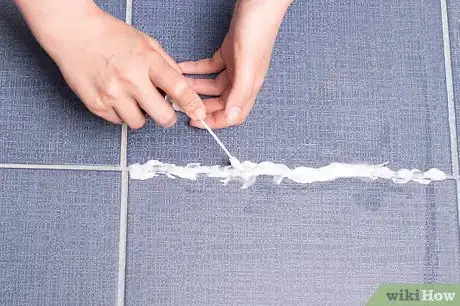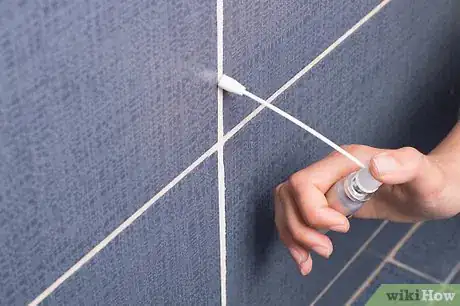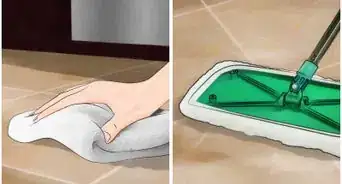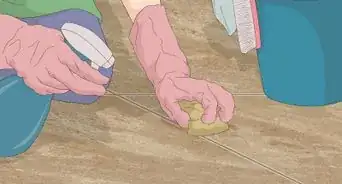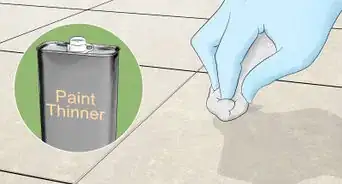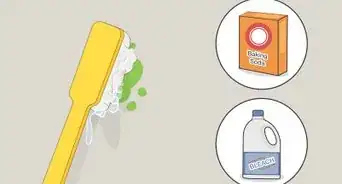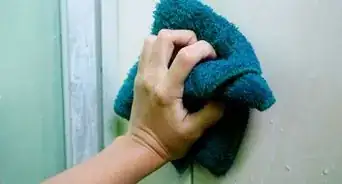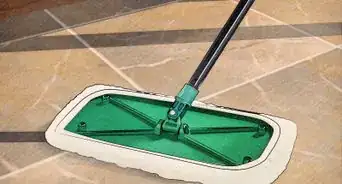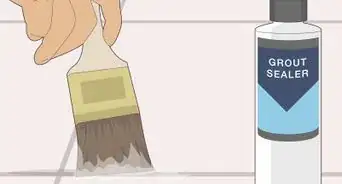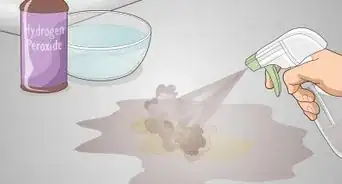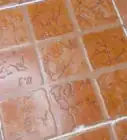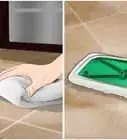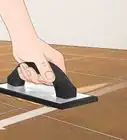This article was co-authored by Art Fricke. Art Fricke is a home renovation and repair specialist and the owner of Art Tile & Renovation based in Austin, Texas. With over 10 years of experience, he specializes in bathroom and kitchen renovations. Art focuses on a single contractor approach to customized renovation work, and performs projects such as installing custom tile showers, fixing tiled shower leaks, replacing cracked tiles, and installing floor and wall tile.
There are 8 references cited in this article, which can be found at the bottom of the page.
This article has been viewed 49,254 times.
Most bathroom tiles host mildew growth if there's a lack of air supplied to the bathtub/shower area. Here are some steps that should help restore it to showroom condition.
Steps
Cleaning the Tiles
-
1Clean the tile surface with a recommended cleaning product. Scrub with an abrasive rag, or rig a nylon bristle drill attachment. Pay extra attention to the bottom section, because that is usually the area with the most mildew. Rinse well.[1]
-
2Rake the joints. Cover the drain. Carefully rake each joint with a diamond carbide rake. Be careful not to slip, or it will leave irreparable scratch marks.[2] The surface should be wet during this part of the process.
- If the grout is too solid to rake, hot water usually helps.
- Remove caulking with a plastic scraper. Avoid using metal scrapers and steel wool, because they will scratch the enamel on the tub.[3]
Applying and Sealing New Grout
-
1Rinse the surface, and towel dry. Mix the grout thoroughly until it comes to a creamy consistency.
-
2
-
3
-
4Dry dust the surface. When the surface is dry, it should look hazy. Polish the tiles with a fine rag, or an old t-shirt. Be careful not to apply pressure on the joints. If there are any stubborn spots on the tiles, they can easily be scraped off with a plastic scraper.[8]
- Gloves and a dust mask should be worn for this.
-
5Apply the caulking. Prepare the surface by thoroughly cleaning and drying. Most caulking won't adhere to a surface that is oily or wet. Apply silicone, or vinyl caulking to tub/tile edge to keep this area watertight. Caulk around the faucet handles, tub spout, and overflow as needed.[9]
-
6
Expert Q&A
Did you know you can get expert answers for this article?
Unlock expert answers by supporting wikiHow
-
QuestionCan I put new grout over old grout?
 Art FrickeArt Fricke is a home renovation and repair specialist and the owner of Art Tile & Renovation based in Austin, Texas. With over 10 years of experience, he specializes in bathroom and kitchen renovations. Art focuses on a single contractor approach to customized renovation work, and performs projects such as installing custom tile showers, fixing tiled shower leaks, replacing cracked tiles, and installing floor and wall tile.
Art FrickeArt Fricke is a home renovation and repair specialist and the owner of Art Tile & Renovation based in Austin, Texas. With over 10 years of experience, he specializes in bathroom and kitchen renovations. Art focuses on a single contractor approach to customized renovation work, and performs projects such as installing custom tile showers, fixing tiled shower leaks, replacing cracked tiles, and installing floor and wall tile.
Home Renovation & Repair Specialist
Warnings
- Steel wool and metal scrapers should be avoided when cleaning the tub, as the enamel can scratch very easily.⧼thumbs_response⧽
- Rubber gloves and a dust mask should be worn throughout most of this process. Grout contains crystalline silica, a known carcinogen.⧼thumbs_response⧽
- Don't pour the water from the grout bucket down the sink. It contains a lot of sediment that can clog the plumbing.⧼thumbs_response⧽
- Diamond carbide blades should only make contact with the grout. The blade can make deep scratch marks in tile glazing. Keeping the surface wet helps to avoid scratching.⧼thumbs_response⧽
Things You'll Need
- Tile cleaner
- Grout
- Diamond carbide rake
- Rubber float
- Grout sponge
- Bathroom caulking
- Sealant
- Buckets
- Rags
- Rubber gloves
- Dust masks
References
- ↑ https://www.bhg.com/homekeeping/house-cleaning/tips/how-to-clean-tile-floors/
- ↑ https://www.youtube.com/watch?v=eNCyUatjUyY
- ↑ https://www.bobvila.com/articles/how-to-remove-caulk/
- ↑ Art Fricke. Home Renovation & Repair Specialist. Expert Interview. 1 July 2020.
- ↑ https://www.bobvila.com/articles/how-to-grout-tile/
- ↑ Art Fricke. Home Renovation & Repair Specialist. Expert Interview. 1 July 2020.
- ↑ https://www.artofmanliness.com/articles/how-to-grout-tile/
- ↑ https://www.popularmechanics.com/home/interior-projects/how-to/a6631/tips-and-tools-to-regrout-your-bathroom/
- ↑ https://www.popularmechanics.com/home/interior-projects/how-to/a6631/tips-and-tools-to-regrout-your-bathroom/
- ↑ Art Fricke. Home Renovation & Repair Specialist. Expert Interview. 1 July 2020.
- ↑ https://www.bobvila.com/articles/how-to-seal-grout/
